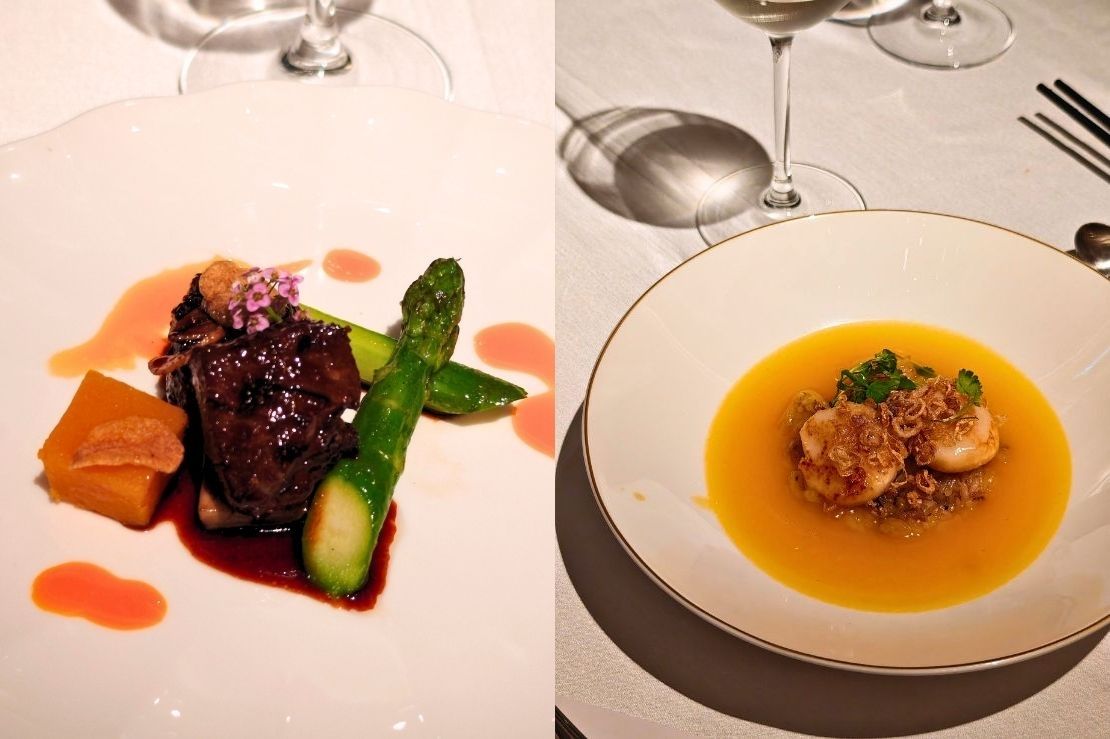The elegant dining room of Royal China, with its soft light and unhurried soundtrack, setting the mood for a paced meal. The menu is traditionally Cantonese with a modern touch, from double-boiled soups to delicate dim sum, giving regulars that familiar refinement expected of the prestigious Raffles Sentosa.
For three nights only, the kitchen carried out something quite special: an eight-course pairing dinner that placed Chef Ling Heng Yao’s food alongside six expressions of Eiheiji Hakuryu sake from Yoshida Sake Brewery in Fukui.
Chef Ling grew up in teahouses, waking before dawn to help his parents prepare for the day. Later, he trained in Hong Kong kitchens where discipline was uncomprmised. “以前係耷低頭咁做多蝕底…冇依家咁多誘惑 (In the past we just kept our heads down and worked hard, without today’s distractions),” he recalled.
That work ethic shaped the way he now leads Royal China. He is exacting, but not in pursuit of flashy reinvention. “我哋唔想話現場編到完全唔似廣東菜 (We don’t want to create something so far that it no longer tastes Cantonese),” he said. Instead, his philosophy is to protect the clarity of Cantonese flavours while introducing small gestures that surprise the palate. This restraint would become the backbone of the pairing menu.
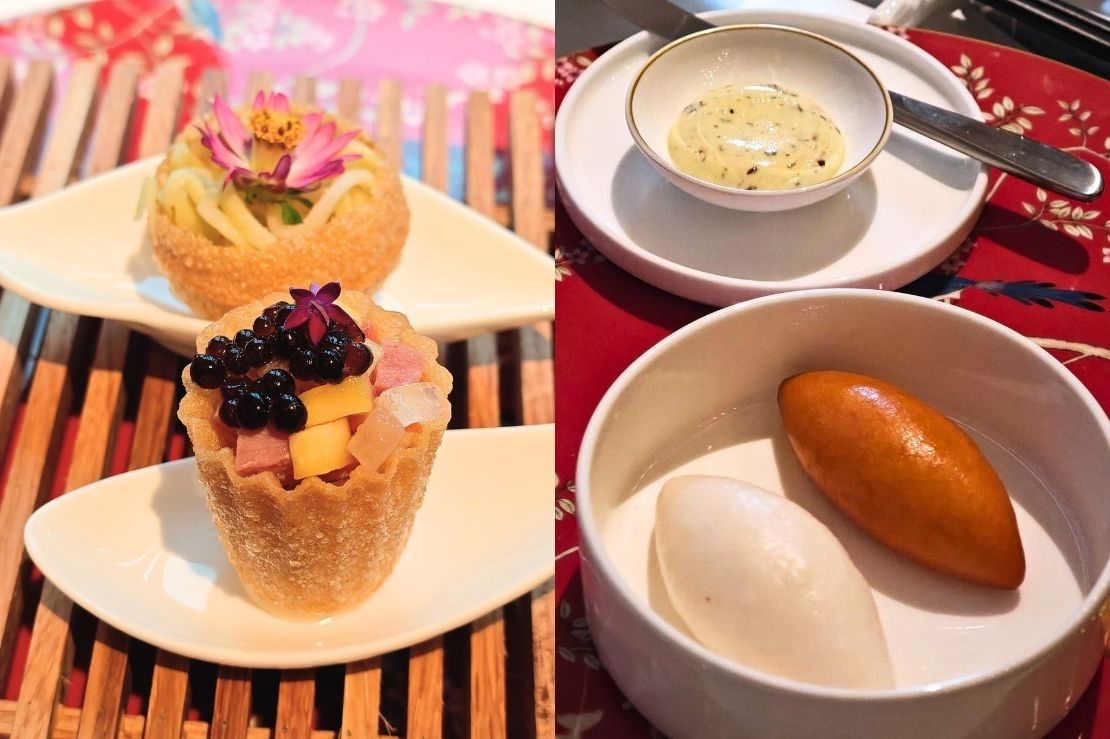
Photos: Kim Choong
Amuse Bouche: 熏鸭时果香醋珍珠,金杯樱花虾青芒果
Smoked Duck Breast, Tropical Fruit, Homemade Chinese Vinegar Pearl, Pickled Green Mango with Crispy Sakura Shrimp (replaced with scallop) Golden Cup
The two bite-sized creations were a playful introduction, each offering contrasting textures and flavours in quick succession. The crisp shell gave way to the tender, springy meat, while the vinegar pearls burst with acidity that bounced on the duck’s smokiness.
鸳鸯馒头配自制橄榄菜牛油
“Yuan Yang Mantou” with Homemade Olive Vegetable Butter
Paired with Eiheiji Hakuryu Kome Tekiteki (14.5%)
The “Yuan Yang Mantou” carried Italian inspiration. The idea came after a meal where bread was served with butter before the meal. Chef Ling wondered why Chinese dining could not have an equivalent moment. He therefore created both the steamed and fried versions; instead of the usual mantou round shape, he made it into the shape of ciriola, and served it with butter infused with olive vegetables (橄榄菜), offering savoury depth against the creamy body of Hakuryu Kome Tekiteki.
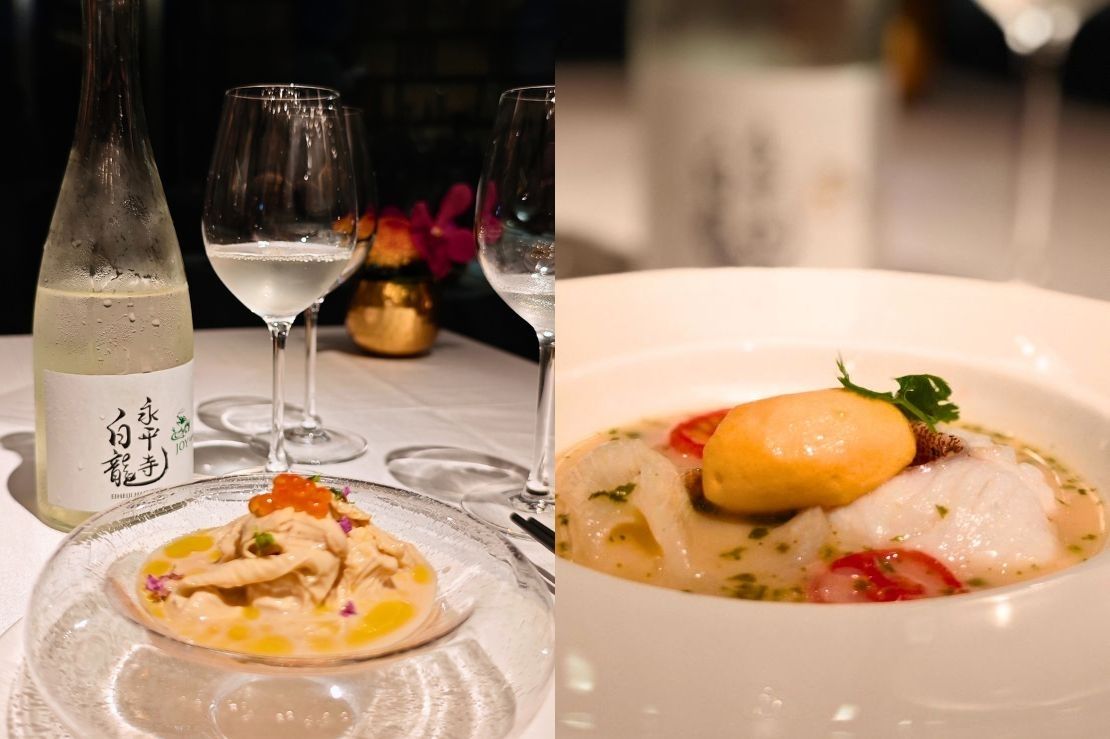
Photos: Kim Choong
鲑鱼子凉拌鲜腐皮
Chilled Fresh Bean Curd Skin, Ikura, Mala Soy Sauce
Paired with Eiheiji Hakuryu Joy (12.5%)
A Cantonese staple was reimagined with Japanese salmon roe and a touch of Sichuan mala. The bean curd skin gave its familiar chew, while the ikura added briny pops and the mala oil delivered a restrained heat without overpowering. The pairing sake, Joy, with its light floral sweetness, extended the spice’s tingling edge while keeping the dish balanced. Yoshida Mako, the seventh-generation toji, explained that low-alcohol sake requires fermentation at cooler temperatures, allowing flavours to emerge slowly.
浓鱼汤斑片花胶鱼茸蛋
Red Grouper Fillet, Fish Maw, Chiffon Fish Ball, Fish Broth
Paired with Eiheiji Hakuryu Toast (15%)
This dish set the tone for the pairing: a fish maw soup, rich yet transparent, floating with handmade fishballs. Unlike the dense fishballs found in street stalls, these were lifted with whipped egg white beaten into the fish paste, a technique that gave them a soft, almost ethereal bite. Chef Ling describes such touches as “驚喜” (little surprises), not inventions for their own sake, but refinements that please the diner. The sake’s toasty notes added an earthy counterpoint to the soup’s sweetness.
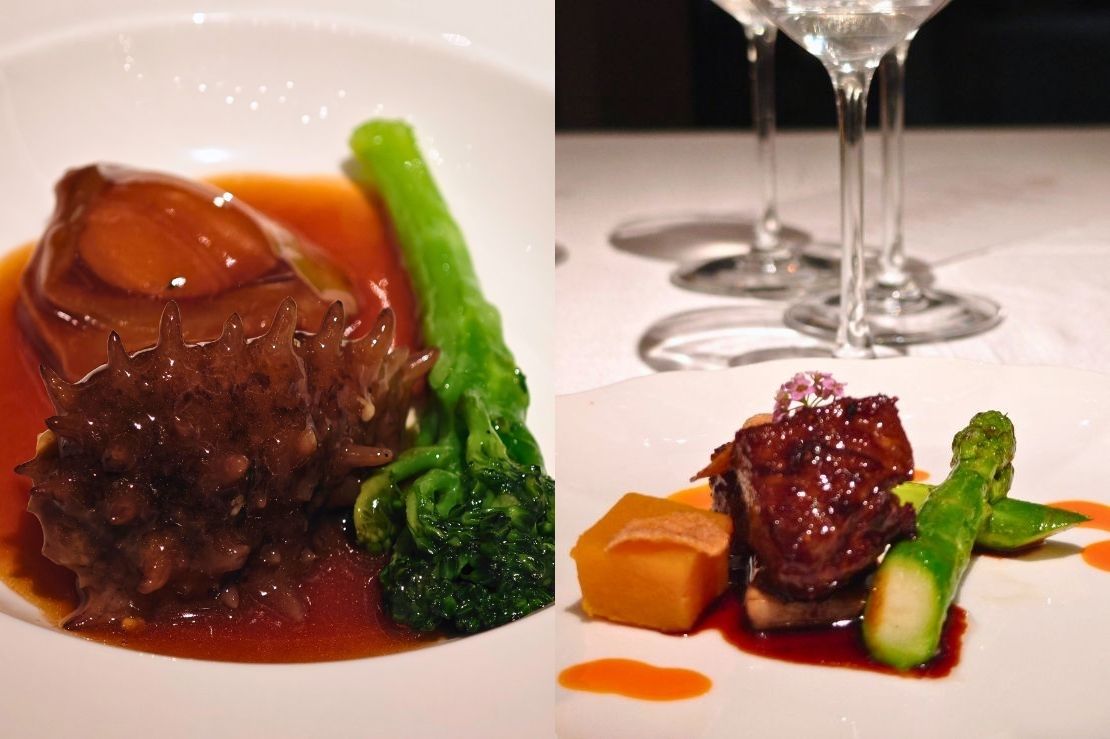
Photos: Kim Choong
鲍汁五头澳洲鲍鱼,酿关东辽参
Stewed 5-Head Australian Abalone with Stuffed Kanto Sea Cucumber in Abalone Sauce
Paired with Eiheiji Hakuryu Rich (15%)
A dish rooted in Cantonese luxury, the abalone and sea cucumber carried deep, oceanic savouriness enriched by a glossy abalone sauce. The abalone’s firm texture and sea cucumber’s softness played against one another. The sake, Rich, brought body and grain-driven taste profile with its rounded sweetness echoing the sauce while accentuate the abalone’s umami flavour.
辣陈醋宫崎A5和牛粒
Sautéed Diced Miyazaki A5 Wagyu Beef in Spicy Vintage Vinegar Sauce
Paired with: Eiheiji Hakuryu Peak (13%)
The wagyu arrived in glossy cubes, its texture sharpened by the aged vinegar and spice. Each mouthful melted in the mouth. The sake, Peak, lived up to its name with lifted aromatics and structure that rose to meet the wagyu’s intensity. Where the vinegar cut through the fat, the sake’s fragrance carried the flavours further, leaving the palate refreshed and ready for the next bite.
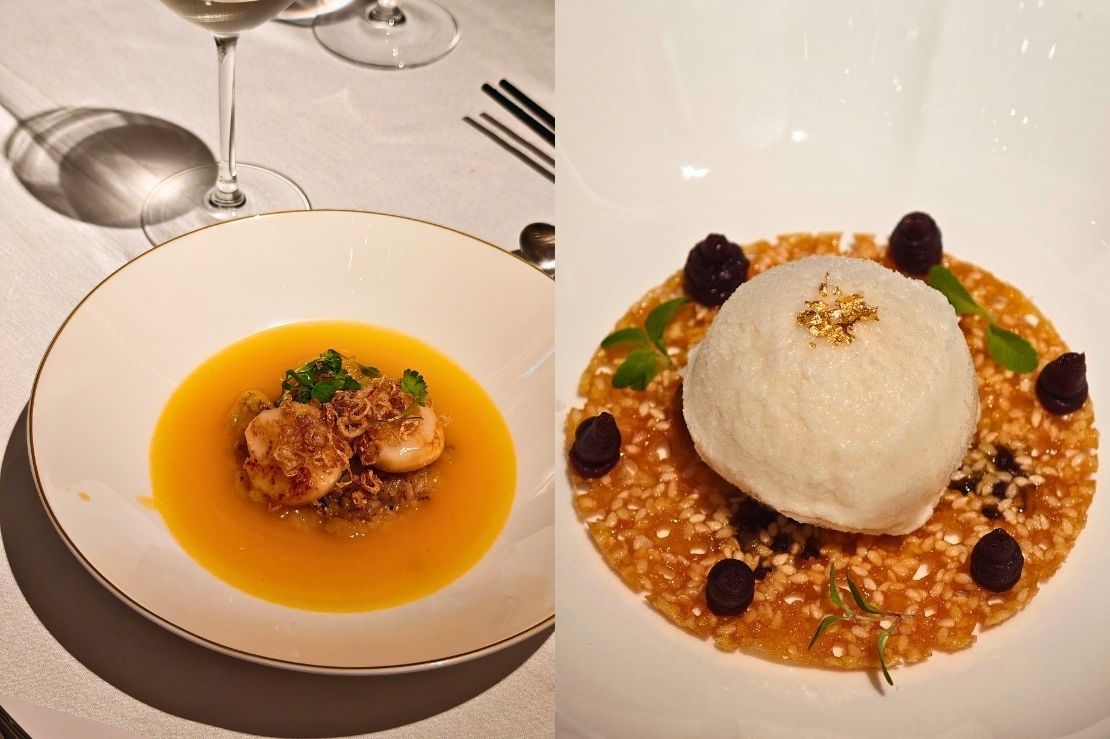
Photos: Kim Choong
龙虾葱油糯米饭
Fragrant Shallot Oil Glutinous Rice with Rock Lobster (replaced with scallop) Served with Lobster Broth
Paired with: Eiheiji Hakuryu Edge (13%)
The glutinous rice, wok-fried with shallot oil until glossy and fragrant, carried a subtle smokiness that met the sweetness of tender scallop, soaked in warm lobster broth reduced from shells with its lingering marine aroma. The sake, Edge, contrasting the dish with its clean finish, bringing out the scallop's sweetness while keeping the palate refreshed.
杏仁雪糕,红豆,芝麻脆饼
Homemade Almond Ice Cream, Azuki Red Bean, Sesame Crisp
A nostalgic close to the meal: creamy almond ice cream paired with Japanese-style red beans, their earthy sweetness offset by the snap of a thin sesame crisp. Light yet textured, it recalled the simplicity of childhood desserts but delivered with refinement. No sake accompanied this course, allowing the flavours to stand on their own as a gentle finale.
What the dinner revealed was that both Cantonese cuisine and sake making are arts of precision and patience. Chef Ling presented his version of “gentle” Cantonese cuisine, while Yoshida’s sakes are about maximising rice’s natural character rather than stripping it away. Neither of the crafts seeks dominance. Instead, both complementing one another to create a balance.
For Chef Ling, it is also about keeping Cantonese cuisine competitive in a cosmopolitan world. Diners in Singapore, he observed, can fly to Guangzhou or Hong Kong for “the real thing.” His challenge is to ensure Royal China offers something equally compelling, even if rooted in familiar forms. Pairing with sake is one way forward, not as a gimmick but as a genuine extension of Cantonese gentleness into another tradition of subtlety. As the dinner progressed, it became clear how adaptable sake could be to Cantonese cuisine. “Sake can pair with a wide range,” said Chef Ling, and this menu proved it.
This dinner was held in Royal China between 23 and 25 July 2025. Address: Raffles Sentosa Singapore at 4 Bukit Manis Rd, Sentosa, 099947 Singapore. +65 6032 4668
- T -
